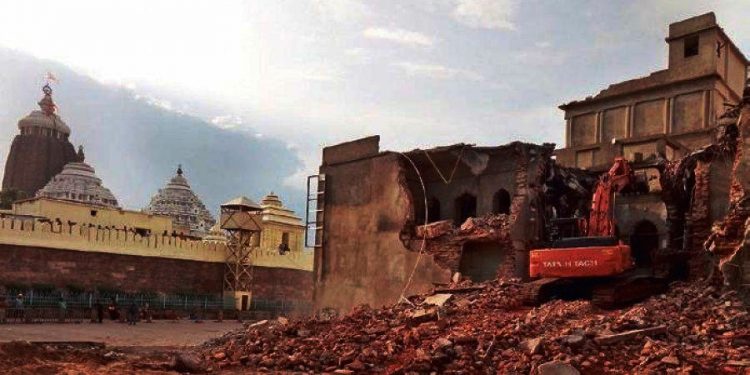Charudutta Panigrahi
The blackmail has been blunted. This is no mindless endorsement of the demolition drive around the Jagannath temple in Puri. The pulling down of dilapidated structures overcrowding the precincts of the ‘Lord of the Cosmos’ is a rare, bold step, taken after centuries of ‘slumming’. The mathas around the Puri temple need to be razed because the Jagannath temple needs more fortification and tidying. Some 5-6 centuries ago these mathas (also the other mathas in general) were intended to impart Sanskrit lessons to resident and visiting young scholars, with boarding facilities for pilgrims and specialised facilities to perform rituals of Jagannath temple. Many of these had good libraries. But now the scholastic relevance of the mathas has waned.
The mathas of Puri were built and supported by ‘Lines of Following’; for instance, Ramanuja Acharya, a seer of Shaivism, set up Emar mutt, Ramananda founded the Bada Akhada matha to impart physical training to servitors to guard the temple and its sanctity. The seers and religious leaders who established mathas were helped by rulers and rich patrons in their endeavour. Land and donations these mathas received belonged to the people. Mathas today are mired in conflicts, say over Mahanta succession, property ownership and cases of hoarding of gold, precious stones and riches. Mathas used to be of and by seers, but for learners. The Puri Gazetter describes mathas thus: “Mathas are monastic houses originally founded with the object of giving religious instructions to chelas or disciples and generally of encouraging a religious life.” Sreemandir is perhaps the only temple on Earth which propounds the tenet ‘All humans are one’.
The oneness is seen in practice, and not just in rhetoric. Patrons, including feudal lords, kings and traders from all over had put up 752 mathas in Puri to accommodate pilgrims from all over the world and provide food and comfort without commercial purposes. This is believed to have inspired the introduction of the langar system at gurudwaras (Guru Nanak had established the Bauli matha in Puri, which is now in ruins).
Mathas are irrelevant today as they do not meet the higher purposes for which they were meant. They are uninhabitable and provide poor living quarters to pilgrims and even the poor and hapless widows during Kartika brata.
Shreekshetra is one of the seven most holy places for Hindus globally and one of the four dhams (Char Dham) considered the highest zones for Hindu faith. Cleaning of the Dham will set an example for the rest of the world to preserve such old temples of faith, which steer humanity.
The Garuda Purana says: “Ayodhyā Mathurā Māyā Kāsi Kāñchī Avantikā | Purī Dvārāvatī chaiva saptaitā moksadāyikāh || (the seven holy places of Hindu faith that are believed to provide salvation)
Mathas are seen as rigid institutions that preserve traditions and not as institutions that change with changing times and norms. They have never been able to transform into institutions that can connect with society as times change. They could not evolve owing to their limited capabilities and intellectual proclivities. A matha today is nothing more than a building because they are bereft of the divine spirit. If it is a decrepit building, then they need not stand between the devotee and the lord.
The state has shown unparalleled decisiveness in clearing the land around the Lord’s abode. In many old cities with similar situations around the world, administrations have not been bold enough to bulldoze encroaching structures. What Odisha has done in Puri sets an example for the rest of the country to follow.
The abode of the Lord of the Cosmos has to be the brightest, strongest and the nattiest. Because that is the least, we mortals (and Odias) can offer as our reverence and prayer. Keep our highest pedestal clean, safe and long-lasting. We cannot neglect our Lord for decadent mathas.
The writer is an economist and public policy expert. He is based in Delhi and can be contacted at charu.panigrahi@gmail.com. Views are personal.






































